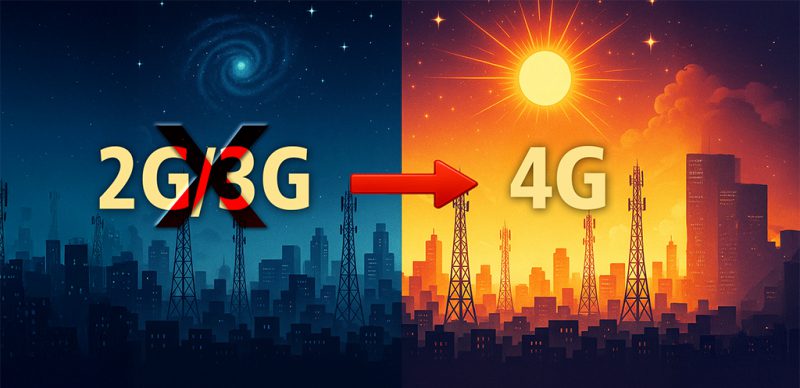The need to migrate from 2G/3G to 4G technology
The dynamic development of telecommunications technologies and constantly growing requirements for network security and reliability make the migration from outdated 2G and 3G technologies to modern LTE standards inevitable. Second and third generation networks, although once the backbone of mobile communications, are now not only insufficient in terms of bandwidth, but also dangerous from a cyber security perspective.
Lack of mutual authentication, weak data encryption, and vulnerability to fake base station attacks (IMSI catchers) are just some of the problems associated with older technologies. In addition, operators in Poland and Europe are systematically phasing out 2G and 3G networks, and devices based on these standards are no longer supported or updated.
In contrast, LTE (and its variants LTE Cat. M1 and NB-IoT) offers high throughput, compliance with modern regulations (NIS2/CER), and robust security mechanisms, including mutual authentication, strong encryption, and data integrity protection. As a result, LTE not only enables infrastructure development and modernization, but also provides greater resilience to cyberattacks and business continuity, which is critical in an era of growing importance of telemetry and IoT.
Below you will find a detailed comparison of 2G/3G and 4G technologies and specific reasons why migrating to LTE is not an option but a necessity today.
| Feature / Technology | 2G (GSM, GPRS) | 3G (UMTS) | 4G (LTE, LTE Cat. M1, NB-IoT) |
|---|---|---|---|
| Network status | Being phased out in the US/EU | Being phased out in the US/EU | Active, expanding |
| Data throughput | Very low (up to 0.1 Mbps) | Low (up to 2 Mbps) | High (even above 100 Mbps) |
| Security | Outdated, vulnerable to attacks | Outdated, vulnerable to attacks | Modern standards, NIS2/CER compliance, regular updates |
| Technical support | No updates, end of support | No updates, end of support | Full support, firmware updates |
| Compliance with standards | Does not meet requirements | Does not meet requirements | Full compliance with current standards and regulations |
| Reliability | Risk of interruptions, failures, declining network capacity | Risk of interruptions, failures, declining network capacity | High reliability, continuity of operation |
| Development potential | None, end-of-life technology | None, end-of-life technology | Open to future technological changes |
| Device availability | Only older, discontinued models | Only older, discontinued models | Wide range of new solutions |
| Possibility of funding for modernization | NO | NO | YES (local cybersecurity programs) |

2G technology is not resistant to cyberattacks. On the contrary, from today’s perspective, 2G has numerous well-known security vulnerabilities, making it susceptible to various types of attacks.
Here are the most important issues:
-
No mutual authentication – only the user authenticates themselves to the network – the network does not authenticate itself to the user. This allows for:
-
Fake base station attacks (IMSI catcher / Stingray) – an attacker can impersonate a base station and intercept calls or data.
-
Weak encryption – the encryption algorithms used in GSM are old and can be broken with today’s equipment:
-
Calls can be eavesdropped on and SMS messages can be intercepted.
-
Lack of data integrity – 2G does not protect against manipulation of transmitted data – it is possible to modify it during transmission.
-
Widespread availability of attack equipment – thanks to cheap SDR (software-defined radio), attacks on 2G networks are now available even to amateurs.
What does this mean in practice?
-
2G networks are very risky from a cybersecurity perspective.
-
Many countries and operators are disabling 2G or restricting its use (e.g., to alarms or older M2M/IoT systems)
Sources:
- https://securitybrief.com.au/story/2g-and-3g-networks-are-open-doors-for-cyber-attacks
- https://hpi.de/oldsite/fileadmin/user_upload/fachgebiete/rabl/Lectures/Lecture_Series/Poster_LSDBR_24/proposal.pdf
- https://securityaffairs.com/1603/security/gsm-mobile-networks.html
- https://www.ventasdeseguridad.com/en/news/latest-news/431-enterprises/19829-study-notes-2g-and-3g-networks-remain-vulnerable-to-attacks.html
The comparison of the security of 2G and 4G technologies in terms of resistance to cyber attacks:
| Feature | 2G (GSM) | 4G (LTE) |
|---|---|---|
| Network authentication | Only the user authenticates the network | Mutual authentication |
| Data encryption | Weak | Strong |
| Data integrity | No protection | Protected |
| Resistance to fake BTS (IMSI catchers) | None | Significantly increased security |
| Network application security | None | Significantly improved mechanisms compared to 2G technology |




